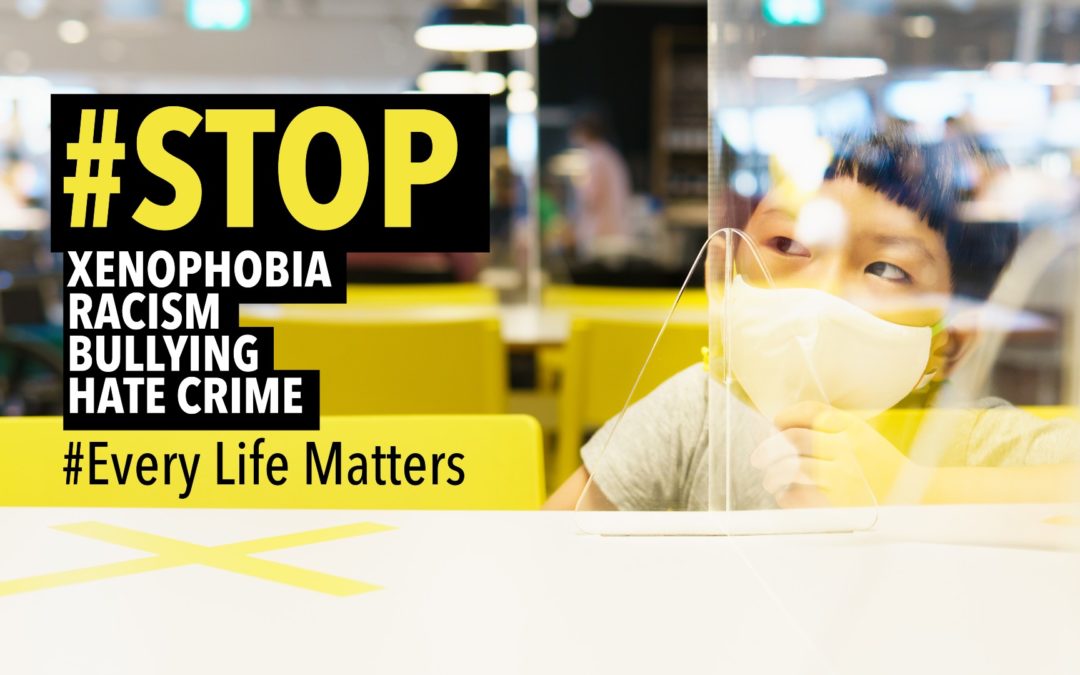By Roben Allong, Patricia Lopez, Iris Yim
COVID-19 has been a jarring wakeup call. While the idea of traditional research on ethnic consumers and their disparate COVID-19 experiences is certainly not a groundbreaking proposition, what clearly will be evident post COVID-19 is one size does not fit all. All COVID-19 experiences are not created equal. Crisis is often a catalyst for innovation and this pandemic is no different. Savvy brands and marketers are already getting out ahead of the “new normal” to innoculate themselves by re-aligning and leading in the best interest in consumers.
As infection numbers and the death toll from the Covid-19 pandemic in the US continue to rise, data with racial breakdown show emerging trends that the pandemic has different impacts on communities of color.
Regardless of whether you do multicultural research or not, the advent of COVID-19 will have a tremendous impact across consumers across all ethnicities and their engagement with brands going forward. According to Nielsen’s most recent Annual Marketing report: The Age of Dissonance, the number one goal of 41% of marketers surveyed was to reach new customers. In the quest for new customers, striking the right tone with brand messaging and communications to broaden audience and reach consumers across all ethnic groups will become increasingly more important. Companies that invest now in better understanding POC (people of color) cultural and social dynamics will come out ahead because of their extensive influence that stretches across every demographic.
This article explores possible contextual and cultural factors behind the pandemic’s impacts specifically on the Hispanic, African American and Asian communities to provide a better understanding and foundation, post COVID-19, for more successful brand interaction and communications, oriented towards these audiences.
African Americans are distrustful of government and fearful of being left further disadvantaged
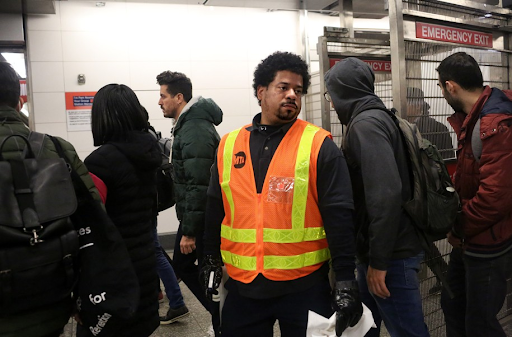
Photo credit Yana Paskova/Getty Images
According to recent Associates Press reports, the COVID-19 death rate among African Americans account for more than one third of the virus deaths even though they account for only 14% of the general population. And while medical and healthcare professionals point to income and equality, healthcare and access disparities that lead to susceptibility, one cannot help but wonder if there are other factors, other parts of the African American story that haven’t been told?
Culturally, most African Americans have been and continue to be mistrustful of messengers that wield large amounts of authority and power over them such as the government, law enforcement, and big business. Based on this, compliance with messages about COVID-19 culturally were not a top priority at the start of the crisis. In fact in a recent Axios poll, more than 63% expressed distrust in President Trump. And less than 60% reported that they trusted the local State Health Department, the National Institute of Health and the World Health Organization (WHO), under indexing compared to other ethnic groups .
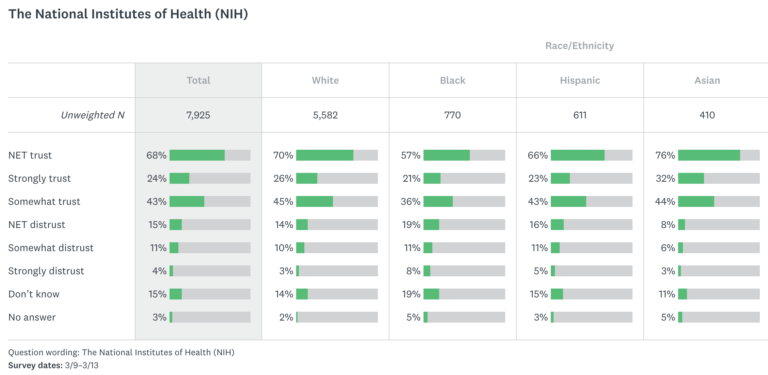
(Source: Axios/SurveyMonkey Poll: Coronavirus and Trust)
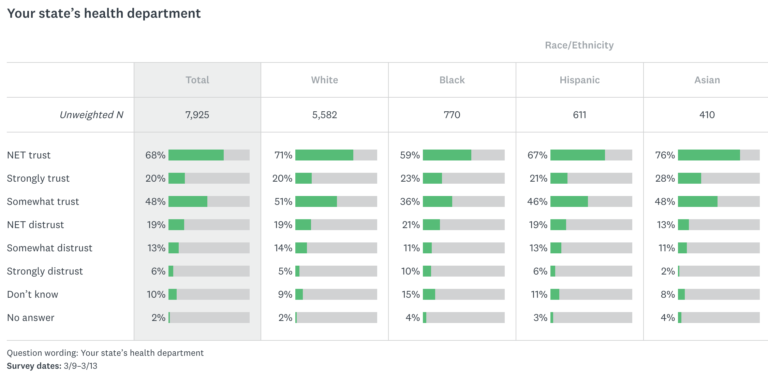
(Source: Axios/SurveyMonkey Poll: Coronavirus and Trust)
In the United States, wearing protective face coverings i.e. masks is neither traditional nor accepted, except for specific jobs that require them and of course, during Halloween. To be frank, masks are stereotypically associated with criminals and attempting to hide one’s identity. African Americans know all too well how quickly they are associated with negative stereotypes and by and large avoid any actions like wearing a face mask that would expose them to further harassment from law enforcement or anybody for that matter.
Contextually, and more importantly, because of urban housing conditions and a preponderance of employment in essential front line, low paying jobs from grocery clerks to delivery people to public transportation and safety workers often in close quarters with others, not only do African Americans not have the luxury of working from their homes, they are forced to unknowingly interact with infected and asymptomatic members of the public. That inability to practice social distancing because of their livelihood leaves them more open and susceptible to becoming infected with the virus.
Lower penetration of laptops and Wifi to continue schooling at home places African American children at a unique disadvantage when school does resume, time and learning lost, a setback that may not be recoverable for some time. The COVID-19 experiences of African Americans are, without a question, quite different from other groups.
Implications:
The old Sophocles adage of killing the messenger (or the brand in this case) because you don’t like the message still holds true today. The lack of trust, common across all generations of African Americans, also extends to big business and brands that have not been/are not authentically engaged with them during this trying time. African Americans, now with more access and influence than ever before on Social Media, can digitally “kill” a brand’s bottom line on megaphones like Twitter, Instagram or Facebook, if they feel its message is tone deaf. And they will do it quickly and indiscriminately. No brand is safe. Just ask… Gucci, Prada, H&M, or Adidas.
Research among African Americans in the new normal post COVID-19 is going to be pivotal going forward to increase audience and sales to avoid costly communication and messaging cleanups. Because African Americans are a very diverse group whose influence spans every demographic and socio-economic segment of the population, tone deaf, inauthentic brand messages that do not acknowledge their COVID experiences decrease engagement, motivation, and ultimately, erode brand currency. Powering up on research among this segment to obtain a deeper understanding of the culture code as they create a new normal is a wise investment to gain valuable new consumers as the marketing fight for consumer dollars looms.
Asian Americans are concerned about discrimination and safety on top of health and finances
Depending on data available and the region where the data is pulled, the infection and death rates among Asian Americans are on par with or slightly lower than the general population.
Majority of Asian Americans are foreign born and have close ties to home countries in Asian. Since the pandemic first broke out in Asia at the end of January, Asian Americans have been watching closely what was happening in Asia and are better informed with the danger of coronavirus and what measures are more effective for self protection and keeping the virus from spreading widely. While the rest of the country are slowly learning to cope with changes to daily life brought by Covid-19 precautions, Asian Americans, were early adopters of social distancing and wearing masks, changes that have been a reality since late January and early February in China, Hong Kong, Taiwan and other parts of Asia. While cultural traditions and experiences have played a tremendous role influencing the level of compliance and consequently, COVID exposure, they have not prepared this segment for the sudden onset of discrimination.
Recently Western countries have encouraged citizens to wear face masks as part of containment measures. While wearing a mask is perceived to be associated with criminology in the West, it’s commonly seen in East Asia. People who live in metropolitan areas with air pollution, frequently wear face masks to keep their faces clean and also filter the air they breathe in. Wearing face masks became an essential component in virus containment during the SARS outbreak in the region in 2002-2003 and has been further integrated into daily life afterwards. When the Covid-19 outbreak first happened in Asia, Asian governments encouraged wearing face masks early on. In Taiwan, despite its close distance and ties with China, so far the island has avoided close down and people in the territory have been able to maintain a normal life. At the writing of this article (04/11/2020), Taiwan had 385 cases and 6 deaths. Since the outbreak of Covid-19, the government has made sure that face masks are available to all residents. Residents can purchase a limited number of masks with ID from local post offices. The Ministry of Education also distributed masks to all schools for all students and teachers for emergency situations.
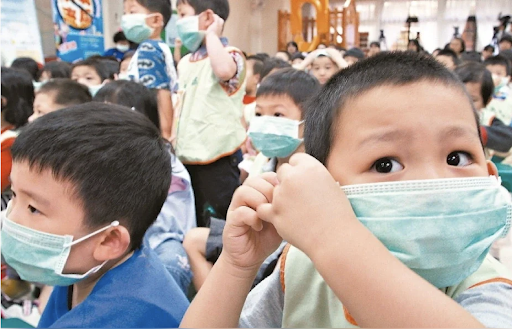
(Source: https://udn.com/news/story/6885/4346281 Taiwan’s Ministry of Education to distribute 6.45 million face masks to schools for use in emergencies when anyone in the school who displays coronavirus symptoms.)
In addition to being informed of the pandemic’s development in Asia, wearing masks, cultural factors such as being group-oriented may also affect compliance and therefore the outcome of the pandemic’s impact on Asian Americans. Culturally Asian Americans tend to be group oriented, more willing to sacrifice individual rights for the greater good of the community. Conversely, non-compliance of virus containment measures is seen as a threat to public health. According to Judy Yuen-man Siu, a medical anthropologist at Hong Kong Polytechnic University, wearing a mask in Hong Kong during an epidemic is considered a civil responsibility and people not wearing a mask will be stigmatized and discriminated against. In China, a Chinese Australian female who went out jogging without wearing a mask in Beijing was reported by netizen and the incident report quickly went viral on social media in China, drawing ire of the entire country. She was fired from her job as a result.
The Covid-19’s notable plight inflicted on Asian Americans is not reflected on the infection numbers and death toll, but rather psychological and emotional. Since the pandemic first broke out in central China, overseas Chinese and East Asians in general (mistaken to be Chinese) have experienced a tremendous rise in xenophobia and discrimination.
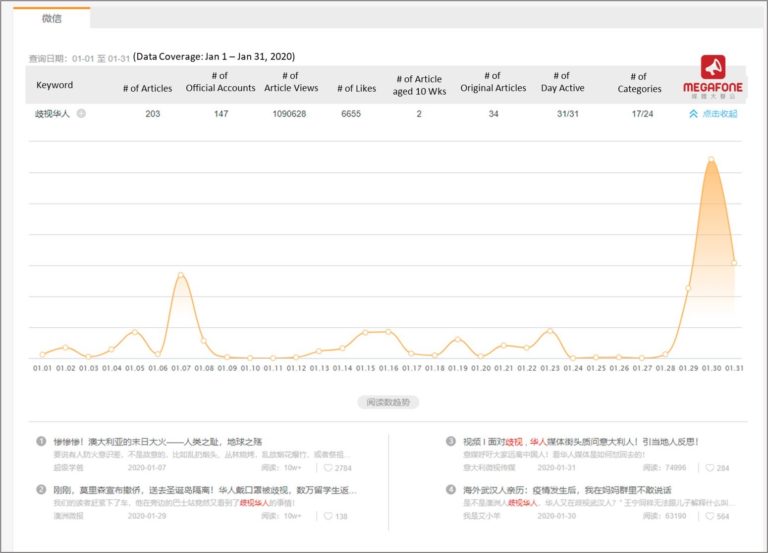
Data source: Megafone (megafonemedia.ca)
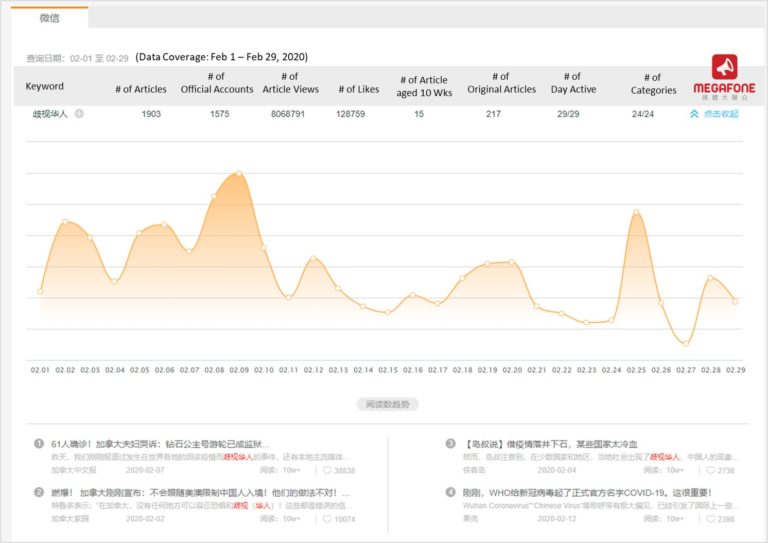
Data source: Megafone (megafonemedia.ca)
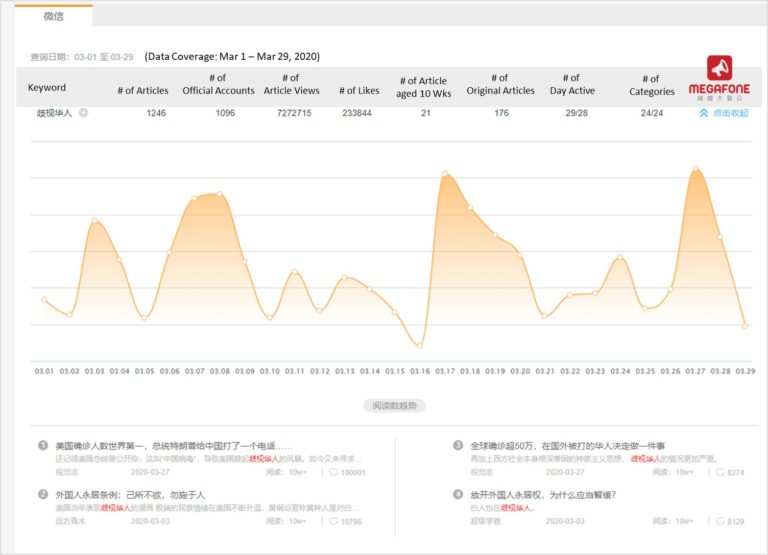
Data source: Megafone (megafonemedia.ca)
There were spikes in mentions of “discrimination against Chinese” on WeChat, the most popular social media in China and among Chinese overseas. Within the first week since Stop AAPI Hate’s launch on March 19, 2020, the reporting platform received over 650 reports of discrimination incidence related to Covid-19. New York State Attorney General Letitia James launched a hotline for reports of hate crimes and discrimination against Asian Americans on March 23, 2020.
Widespread xenophobia against Chinese prompted social media campaigns such as #JeNeSuisPasUnVirus, kickstarted by the French Chinese community to highlight the xenophobia they experienced. In the U.S., two campaigns that stand out, #WashtheHate and Racism Is Contagious, were launched as a response to discrimination against Asian Americans. The #WashtheHate campaign was created by multicultural ad agency IW Group and instantly resonated and gained support from Asian American influencers including Celia Au (Wu Assassins) and Tzi Ma (Mulan, The Man in the High Castle) who personally experienced harassment. Racism is Contagious was spearheaded by Asian American media outlet Nextshark and multicultural ad agency Admerasia and other allied groups and features an interactive map of reported incidences of discrimination from reliable news outlets.
Interestingly, fear for hate crimes and concerns about safety also drove gun sales among Asian Americans in some areas. There have been news reports in Washington and California where the outbreaks of the virus first happened that there was an increase in gun purchase among Asian Americans, driven by fear of xenophobia and racist violence. On WeChat, there are also local support groups for racist violence alerts.
Implications:
Asian American as a consumer segment traditionally has been underrepresented and misrepresented in mainstream media. Brand messaging that conveys a united stand on important issues such as discrimination during times of crisis is more apt to be looked on favorably and get more traction in the community. Brands can also highlight the positive by thanking healthcare workers on the frontlines since Asian Americans are overrepresented in this field.
Increasing awareness of the issue of discrimination and showing support for Asian Americans translates beyond building a connection with Asian American consumers in the US and will also help brands build rapport with a much broader consumer base in Asia given the reach of social media and internet. Since the outbreak of the pandemic, brands have been pivoting messaging to show support for employees and consumers and how they contribute to the fight against Covid-19. Contribution marketing is important. However, it’s equally important to contribute to the emotional health of consumers. Crisis brings out the good and bad in human nature. The Together, Let’s #Do Good campaign from Prudential Singapore is a good example of how a brand can take a stand against discrimination and encourage positive emotions and behaviors during times of crisis.
Hispanics during COVID-19 are dealing with more than just the fear of the virus itself.
Among Hispanics, the financial weight of depending on their weekly paycheck to survive has become a heavier stress point due to the fact that their jobs have come to a halt since shelter-in-place came into effect. Similar to many African American consumers, Hispanics tend to be hourly employees who do not reap the benefits of the salaried workers with extended pay and benefits. According to a recent Pew Research poll, more Hispanics than the general population reported someone in their household had lost a job or had to take a pay cut due to Covid-19.
The coronavirus outbreak has made their job even more precarious; risking their lives to save their livelihood. While many employers have stepped up and provided them with safety gear such as masks and gloves, those who work in construction or as gardeners/landscapers for example are relying on their own means to stay safe.
As part of their story, one of the greatest challenges Hispanics face is adapting their behavior to comply with social distancing guidelines. Culturally, family and gatherings are vital to this community. How is it that adult children can’t visit their parents? Or that grandparents can’t celebrate their grandchildren’s birthdays? That all planned festivities and celebrations now have to be cancelled or postponed. That NO ONE can attend a family members funeral/burial services – for them, this is insane and inhumane!! Their biggest challenge is understanding that even immediate family is a risk to health and welfare.
Furthermore, Hispanics are culturally programmed to shop for groceries on a daily basis in their countries of origin. In the United States, it has become a weekly or bi-weekly activity that tends to coincide with pay day, and usually makes for a family experience. Shopping to cover large periods of time i.e. shelter in place, is not possible because their budgets are still designed to cover shorter periods of time. Therefore, it’s business as usual even with warnings/restrictions of going into grocery stores. Supermarkets that cater to this segment have done a great job of adjusting to the new regulations in order to keep their stores open and stocked for these consumers. Northgate, a Mexican owned chain of supermarkets, for example was the first to implement plexiglass barriers for their cashiers and first to designate special shopping hours for seniors. They are doing everything they can to keep their customers safe, given that not all are complying with new regulations. Nonetheless, there are still entire families shopping at the store, not everyone wears masks and some still struggle with the 6’ feet social distancing guidelines, even with markers on the floor.
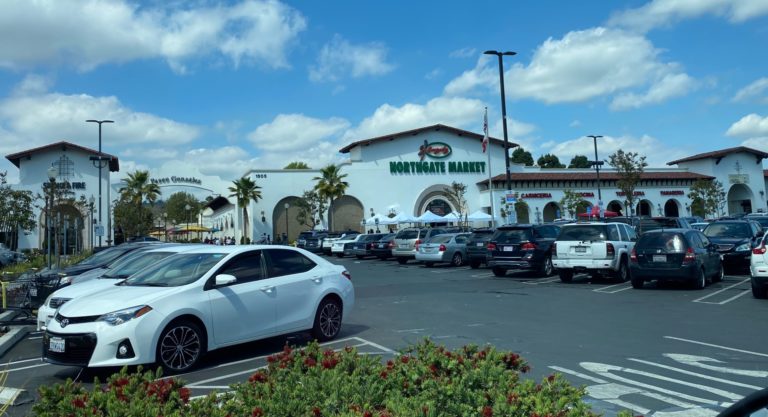
COVID-19 Ethnic Disparity
(Picture taken at Northgate Market La Habra store on April 11, 2020)
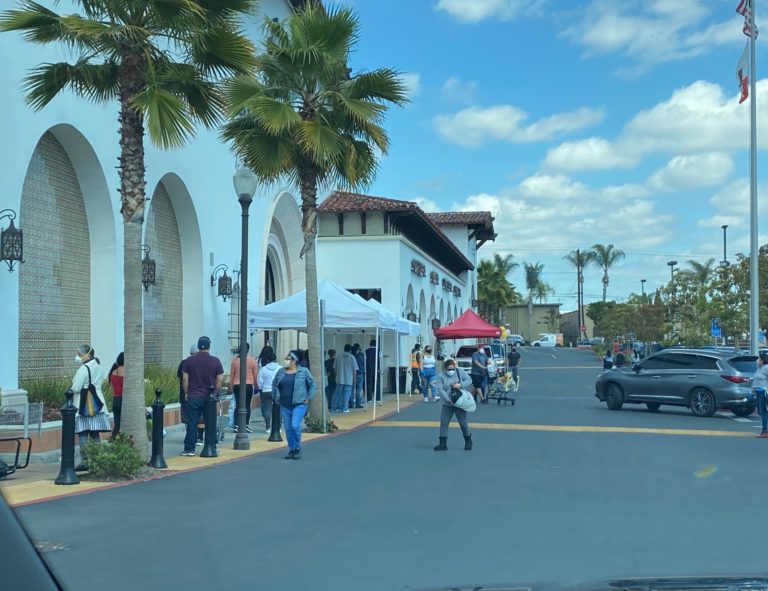
COVID-19 Ethnic Disparity
(Picture taken at Northgate Market La Habra store on April 11, 2020)
Change is difficult for everyone, but especially for a segment that thrives on family time and family interaction. Perhaps it’s part of the fatalistic mentality that Hispanics are known for and is an important part of the overall culture; it’s all in God’s hands/God will protect us from evil. Or simply the fact that they must continue to risk what needs to be risked in order to continue to provide for their families and for their mental/social well-being.
Implications:
While government directives around COVID-19 are still evolving at the time of writing of this article, one key element that will continue to help address the stay at home ordinance is to continue to provide the Hispanic community with factual information in terms and situations they can understand and relate to. This is critical to overcoming both cultural and language barriers and ensuring greater compliance. Univision and Telemundo have done a great job of having their talent featured on PSAs and local news personalities provide PSA segments throughout their daily programing – stay home, don’t visit family and friends, wash your hands, wear a mask, addressing dangers of cross contamination when wearing gloves, etc. to connect with and motivate the community. For most Hispanics, like other ethnicities, being left in even more tenuous situations post COVID, unpredictable and uncertain economic effects is their lingering concern.
In summation, implications across these ethnicities presented suggest that it will not be business as usual because of their diverse experiences. Resuming the same way of thinking and business among people of color pre-COVID is probably not the smartest option for brand and business growth. While we don’t have the answers today and brands will have to make decisions as they go, it’s clear that these disparate COVID experiences will help dictate the future. Brands that stay relevant by investing now in more targeted consumer-centric perspectives, cultural understanding to connect and engage more deeply as consumers navigate the “new” normal will earn their respect and patronage. The COVID crisis is still fluid. Frankly, it’s a rough time and some brands will disappear. Those that survive will need to be even more agile and relevant in their communications and messaging to win in the decade ahead. Ensuring that people of color are emotionally and physically engaged across multiple channels is needed more than ever.

